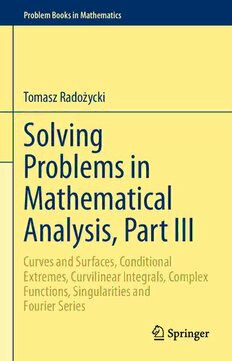Table Of ContentProblem Books in Mathematics
Tomasz Radożycki
Solving
Problems in
Mathematical
Analysis, Part III
Curves and Surfaces, Conditional
Extremes, Curvilinear Integrals, Complex
Functions, Singularities and
Fourier Series
Problem Books in Mathematics
SeriesEditor:
PeterWinkler
DepartmentofMathematics
DartmouthCollege
Hanover,NH03755
USA
Moreinformationaboutthisseriesathttp://www.springer.com/series/714
Tomasz Radoz˙ycki
Solving Problems
in Mathematical Analysis,
Part III
Curves and Surfaces, Conditional Extremes,
Curvilinear Integrals, Complex Functions,
Singularities and Fourier Series
TomaszRadoz˙ycki
FacultyofMathematicsandNatural
Sciences,CollegeofSciences
CardinalStefanWyszyn´skiUniversity
Warsaw,Poland
ScientificreviewforthePolishedition:JerzyJacekWojtkiewicz
BasedonatranslationfromthePolishlanguageedition:“Rozwia˛zujemyzadaniazanalizy
matematycznej” cze˛s´c´ 3 by Tomasz Radoz˙ycki Copyright ©WYDAWNICTWO OS´WIA-
TOWE“FOSZE”2015AllRightsReserved.
ISSN0941-3502 ISSN2197-8506 (electronic)
ProblemBooksinMathematics
ISBN978-3-030-38595-8 ISBN978-3-030-38596-5 (eBook)
https://doi.org/10.1007/978-3-030-38596-5
MathematicsSubjectClassification:00-01,00A07,40-XX,30-XX,41-XX
©SpringerNatureSwitzerlandAG2020
Thisworkissubjecttocopyright.AllrightsarereservedbythePublisher,whetherthewholeorpartof
thematerialisconcerned,specificallytherightsoftranslation,reprinting,reuseofillustrations,recitation,
broadcasting,reproductiononmicrofilmsorinanyotherphysicalway,andtransmissionorinformation
storageandretrieval,electronicadaptation,computersoftware,orbysimilarordissimilarmethodology
nowknownorhereafterdeveloped.
Theuseofgeneraldescriptivenames,registerednames,trademarks,servicemarks,etc.inthispublication
doesnotimply,evenintheabsenceofaspecificstatement,thatsuchnamesareexemptfromtherelevant
protectivelawsandregulationsandthereforefreeforgeneraluse.
Thepublisher,theauthors,andtheeditorsaresafetoassumethattheadviceandinformationinthisbook
arebelievedtobetrueandaccurateatthedateofpublication.Neitherthepublishernortheauthorsor
theeditorsgiveawarranty,expressedorimplied,withrespecttothematerialcontainedhereinorforany
errorsoromissionsthatmayhavebeenmade.Thepublisherremainsneutralwithregardtojurisdictional
claimsinpublishedmapsandinstitutionalaffiliations.
ThisSpringerimprintispublishedbytheregisteredcompanySpringerNatureSwitzerlandAG.
Theregisteredcompanyaddressis:Gewerbestrasse11,6330Cham,Switzerland
Preface
This book is the third and last part of the collection of problems for students in
theirfirst2yearsofundergraduatemathematicalanalysis.Itisintendedtoinclude
all the material required from the students in the three–four semesters, although
moreambitiousreaderswillprobablydiscoversomegaps(e.g.,Lebesgue’sintegral,
Fourier’stransform,distributions).Duetothelimitedvolumeofthebook,however,
Ihadtomakeachoice.
This last part is intended for second-year students who have already gained
significantexperienceinoperatingvariousformulas.Verydetailedtransformations,
which appeared in the previous two parts, would lead to excessive growth of the
volume. Therefore, when possible, I omit some computational details, referring to
theresultsobtainedinthepreviousvolumes.Ialsoassumethatthereaderisalready
familiarwithsomeknownintegrals(e.g.,Gaussian)andthattheydonotrequireany
separatederivation.
The chapters devoted to differential forms and oriented integrals are presented
ina“parallel”way,sothatthereadercaneasilyseetherelationbetweenthevector
descriptionandthatusingforms.
Warsaw,Poland Tomasz Radoz˙ycki
v
Contents
1 ExaminingCurvesandSurfaces.......................................... 1
1.1 FindingCurvatureandTorsionofCurves........................... 2
1.2 Examiningk-SurfacesinN Dimensions............................ 18
1.3 ExaminingRuledSurfaces........................................... 31
1.4 ExercisesforIndependentWork..................................... 37
2 InvestigatingConditionalExtremes...................................... 41
2.1 UsingtheMethodoftheLagrangeMultipliers..................... 42
2.2 LookingforGlobalExtremes........................................ 56
2.3 ExercisesforIndependentWork..................................... 65
3 InvestigatingIntegralswithParameters................................. 67
3.1 ExaminingLimitsandContinuity................................... 69
3.2 DifferentiatingwithRespecttoParameters......................... 76
3.3 IntegratingoverParameters.......................................... 97
3.4 ExercisesforIndependentWork..................................... 101
4 ExaminingUnorientedCurvilinearIntegrals........................... 103
4.1 FindingAreaofSurfaces ............................................ 104
4.2 CalculatingVariousCurvilinearIntegrals........................... 114
4.3 ExercisesforIndependentWork..................................... 121
5 ExaminingDifferentialForms ............................................ 123
5.1 StudyingtheExteriorFormsOperatingonVectors................. 125
5.2 PerformingVariousOperationsonDifferentialForms............. 133
5.3 CalculatingExteriorDerivatives..................................... 145
5.4 LookingforPrimitiveForms ........................................ 149
5.5 FindingPotentialsinR3 ............................................. 164
5.6 ExercisesforIndependentWork..................................... 176
vii
viii Contents
6 ExaminingOrientedCurvilinearIntegrals.............................. 179
6.1 CalculatingIntegralsoverCurves ................................... 181
6.2 CalculatingIntegralsoverSurfaces.................................. 189
6.3 UsingStokes’Theorem.............................................. 198
6.4 ExercisesforIndependentWork..................................... 217
7 StudyingFunctionsofComplexVariable................................ 219
7.1 ExaminingtheHolomorphicityofFunctions....................... 220
7.2 FindingDomainsofConvergenceofComplexSeries.............. 233
7.3 CalculatingContourIntegrals ....................................... 237
7.4 UsingCauchy’sTheorem............................................ 245
7.5 LookingforImagesofSets.......................................... 258
7.6 ExercisesforIndependentWork..................................... 264
8 InvestigatingSingularitiesofComplexFunctions ...................... 267
8.1 IdentifyingtheTypesofSingularities............................... 268
8.2 ExpandingFunctionsintoLaurentSeries........................... 278
8.3 UsingtheResidueTheoremtoCalculateDefiniteIntegrals ....... 289
8.4 UsingResidueTheoremtoFindSumsofSeries.................... 304
8.5 ExercisesforIndependentWork..................................... 312
9 DealingwithMultivaluedFunctions ..................................... 315
9.1 AnalyticallyContinuingFunctions.................................. 316
9.2 CalculatingIntegralsInvolvingFunctionswithBranchPoints .... 327
9.3 ExercisesforIndependentWork..................................... 357
10 StudyingFourierSeries.................................................... 359
10.1 ExaminingExpandabilityofFunctionsintoFourierSeries........ 360
10.2 FindingFourierCoefficients......................................... 363
10.3 ExercisesforIndependentWork..................................... 373
Index............................................................................... 375
Definitions and Notation
Inthisbookseriesthenotationandconventionsadoptedintheformertwopartsare
used.Severaladditionalindicationsaregivenbelow.
• Partialderivativesareoftendenotedinthefollowingbriefway,e.g.,∂/∂x :=∂ ,
x
∂/∂ϕ :=∂ ,etc.
ϕ
• The versors of the coordinate axes are denoted as e(cid:2) , e(cid:2) , e(cid:2) . Similarly for the
x y z
spherical variables the following notation is used: e(cid:2) , e(cid:2) , e(cid:2) defined with the
r θ ϕ
formulas(5.1.22),(5.1.23),and(5.1.24).
• ThecomplexplaneisdenotedwithCandthecompactifiedplanewithC¯.
• Inthechaptersdealingwiththefunctionsofthecomplexvariable(i.e.,7,8,and
9),incontrasttotheotherchaptersofthebookandtothepreviousvolumes,the
symbol “ln” denotes the natural logarithm, in order to avoid collision with the
symbol“log”reservedforthecomplexlogarithm.
ix
Chapter 1
Examining Curves and Surfaces
Thepresentchapterisconcernedwithbasicpropertiesofcurvesandsurfaces.Bya
curve in RN, we understand the continuous function γ : [a,b] → RN (in R3 we
willwriteγ(cid:2)(s)orr(cid:2)(s)).Thus,onecansaythatthecurveistheimageoftheinterval
[a,b].Ifthefunctionγ isdifferentiable,thecurveisalsocalleddifferentiable.
Ifagivencurvehascusps,itcanbepiecewisedifferentiable.Ifthefunctionγ is
oftheclassCn,thecurveisalsocalledoftheclassCn.Ifacurveisofsufficiently
highclassforagivenproblem,itiscalledasmoothcurve.Naturallyitmayalsobe
piecewisesmooth.AcurveinR3isoftendefinedasanintersectionoftwosurfaces.
Unlessstatedotherwise,itwillbeassumedbelo(cid:2)wthatN(cid:2) =3.
(cid:2) (cid:2)
Thecurvatureofacurveisdefinedasκ = (cid:2)dT(cid:2)/ds(cid:2) = T(cid:2)(cid:4)(s),wheres ∈ [a,b]
(cid:2)
denotestheparameterandT(s)isthevectortangenttothecurveatthepointlabeled
bys,normalizedtounity.Withtheappropriatechoiceofs,onehasT(cid:2)(s)=γ(cid:2)(cid:4)(s).
The vector N(cid:2)(s) = κ−1T(cid:2)(cid:4)(s) is the normal vector again normalized to unity.
Theso-calledbinormalvectorisdefinedasB(cid:2) =T(cid:2) ×N(cid:2) andistheunitvectortoo.
(cid:2) (cid:2) (cid:2)
Theorthonormalsystemcomposedofthesethreevectors(T,N,andB)constitutes
theFrenetframe.Inturn,theplanesdesignatedbytheFrenetframe,respectively
(cid:2)
called the normal plane (that perpendicular to T), the straightening plane (that
(cid:2) (cid:2)
perpendiculartoN),andthestrictlytangentplane(thatperpendiculartoB),create
the Frenet trihedron. In some textbooks, however, the Frenet trihedron refers to
(cid:2) (cid:2) (cid:2)
vectorsT,N,andB andnotplanes.
ThefollowingsystemofFrenet’sequationscanbederived(seeProblem2for
thedetails):
T(cid:2)(cid:4)(s)=κN(cid:2)(s), (1.0.1a)
N(cid:2)(cid:4)(s)=−κT(cid:2)(s)+τB(cid:2)(s), (1.0.1b)
B(cid:2)(cid:4)(s)=−τN(cid:2)(s). (1.0.1c)
Naturallyκ andτ areingenerals-dependent.
©SpringerNatureSwitzerlandAG2020 1
T.Radoz˙ycki,SolvingProblemsinMathematicalAnalysis,PartIII,ProblemBooks
inMathematics,https://doi.org/10.1007/978-3-030-38596-5_1

